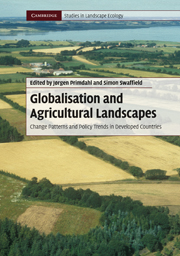Book contents
- Frontmatter
- Contents
- List of Contributors
- Preface
- 1 Globalisation and the sustainability of agricultural landscapes
- 2 Agricultural liberalisation, multifunctionality and the WTO: competing agendas for the future of farmed landscapes
- 3 Globalisation of agricultural landscapes: a land systems approach
- 4 Agricultural landscape changes through globalisation and biodiversity effects
- 5 Swiss agricultural policy reform: landscape changes in consequence of national agricultural policy and international competition pressure
- 6 Local landscape consequences of macro-scale policy reform: the New Zealand experiment
- 7 Rural landscape differentiation in the face of changing demands and policies: a typology of rural areas in Portugal
- 8 Globalisation and the local agricultural landscape: current change patterns and public policy interventions
- 9 From totalitarian to democratic landscapes: the transition in Estonia
- 10 Rural landscape change as a product of US federal policy
- 11 New approaches for urban–rural areas in Dutch spatial planning
- 12 Restoring agricultural landscapes in shrinking cities: re-inventing traditional concepts in Japanese planning
- 13 Globalisation and local agricultural landscapes: patterns of change, policy dilemmas and research questions
- Index
- References
9 - From totalitarian to democratic landscapes: the transition in Estonia
Published online by Cambridge University Press: 05 June 2012
- Frontmatter
- Contents
- List of Contributors
- Preface
- 1 Globalisation and the sustainability of agricultural landscapes
- 2 Agricultural liberalisation, multifunctionality and the WTO: competing agendas for the future of farmed landscapes
- 3 Globalisation of agricultural landscapes: a land systems approach
- 4 Agricultural landscape changes through globalisation and biodiversity effects
- 5 Swiss agricultural policy reform: landscape changes in consequence of national agricultural policy and international competition pressure
- 6 Local landscape consequences of macro-scale policy reform: the New Zealand experiment
- 7 Rural landscape differentiation in the face of changing demands and policies: a typology of rural areas in Portugal
- 8 Globalisation and the local agricultural landscape: current change patterns and public policy interventions
- 9 From totalitarian to democratic landscapes: the transition in Estonia
- 10 Rural landscape change as a product of US federal policy
- 11 New approaches for urban–rural areas in Dutch spatial planning
- 12 Restoring agricultural landscapes in shrinking cities: re-inventing traditional concepts in Japanese planning
- 13 Globalisation and local agricultural landscapes: patterns of change, policy dilemmas and research questions
- Index
- References
Summary
Introduction
This chapter outlines the trajectory of rural landscape changes from the 1990s onward following the fall of communist regimes in Eastern Europe, with a focus on Estonia. The most important driver of change has been the transition from the totalitarian system into democracy and from a centralised planned economy to a market economy. The chapter analyses traces of change in landscape left by the transition of the political economy (see Cosgrove, 1984) through four major themes: the politico-social context, landscape patterns, landscape practices and functions, and the image of country life.
First, the dynamic that underlies the rest of the analysis is the changing politico-social context, as a consequence of reforms such as free elections and reconnecting to global markets. One of the most significant processes that influenced rural and agricultural landscapes after the collapse of communism was long yearned for property reform, which dismantled the collective land-use system. Formerly large fields under common ownership were divided into privately owned small plots, often following the patterns of the 1930s. Restitution also had its downsides; the most remarkable of them was that frequently the new owners lived many kilometres away, and often lacked skills or interest needed to cultivate the land.
Second, the reforms had a direct influence upon landscape patterns, through depopulation of the countryside due to urbanisation. This resulted in abandonment of agricultural activities and production, especially in marginal areas during the mid 1990s.
- Type
- Chapter
- Information
- Globalisation and Agricultural LandscapesChange Patterns and Policy trends in Developed Countries, pp. 169 - 184Publisher: Cambridge University PressPrint publication year: 2010
References
- 2
- Cited by



